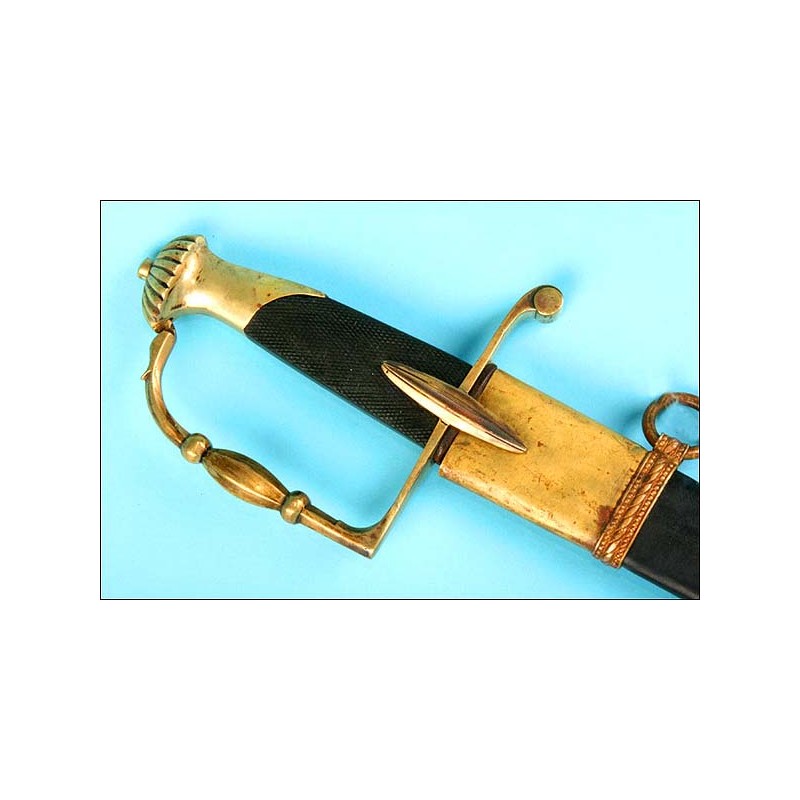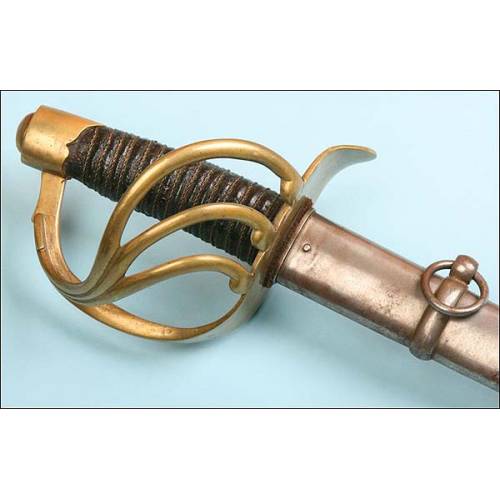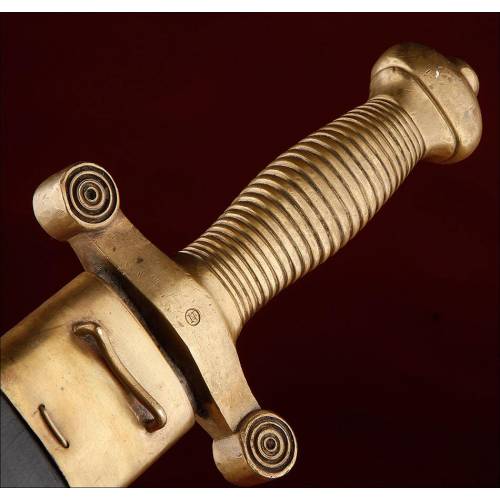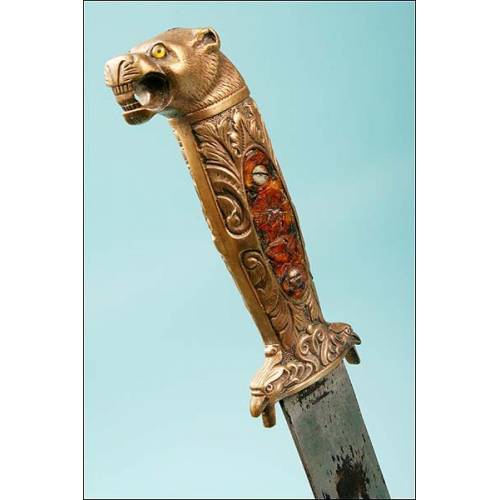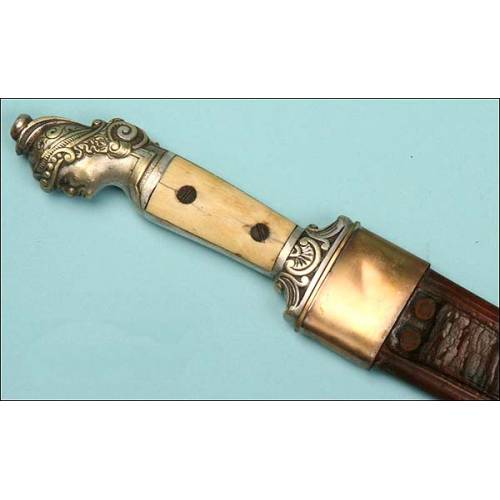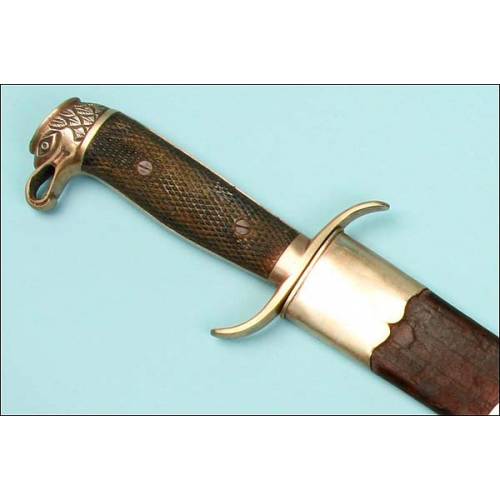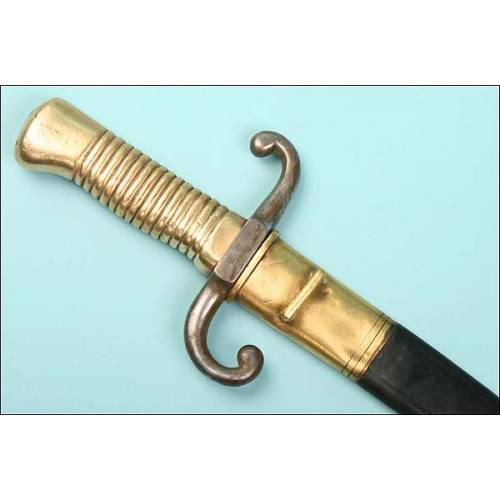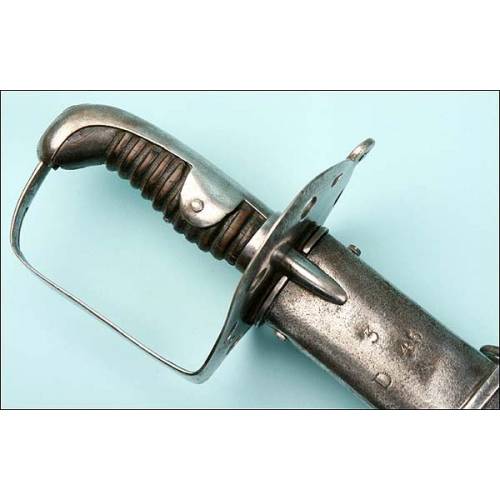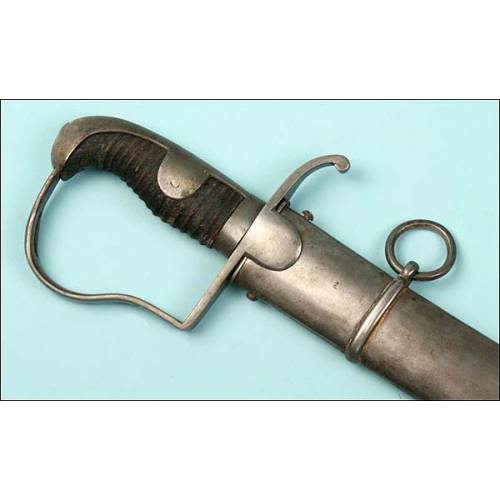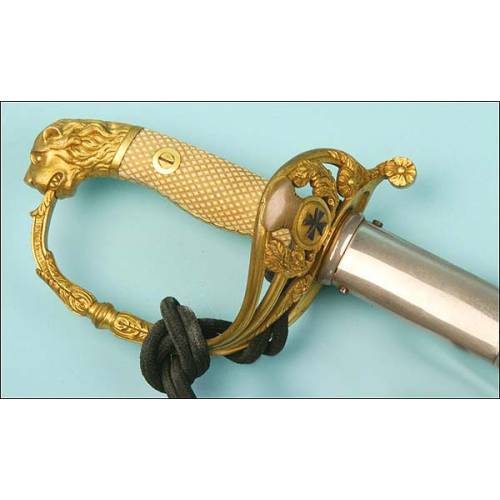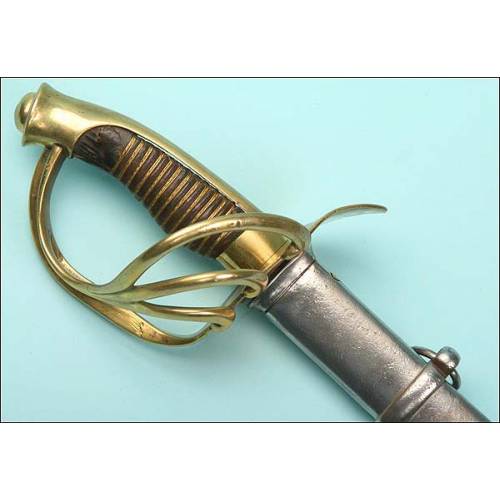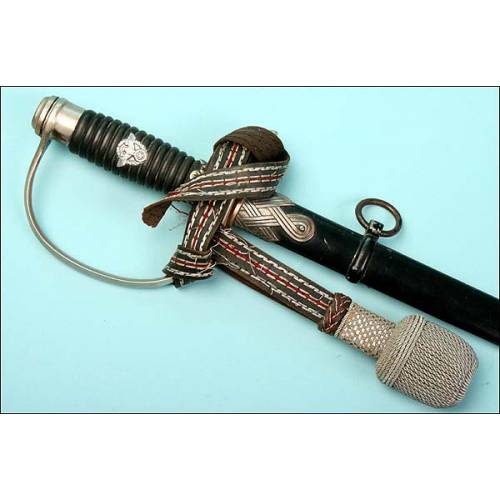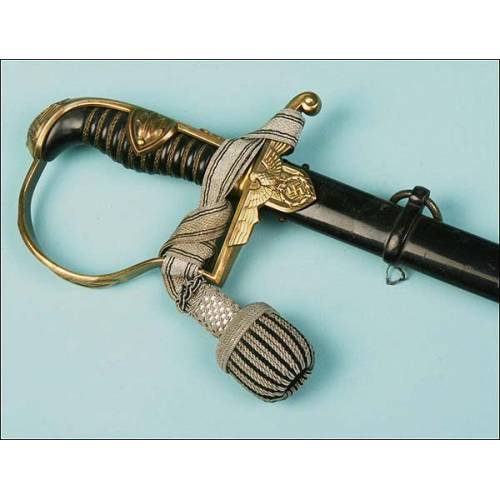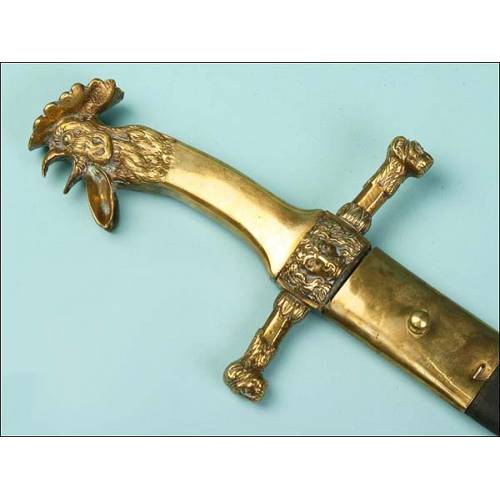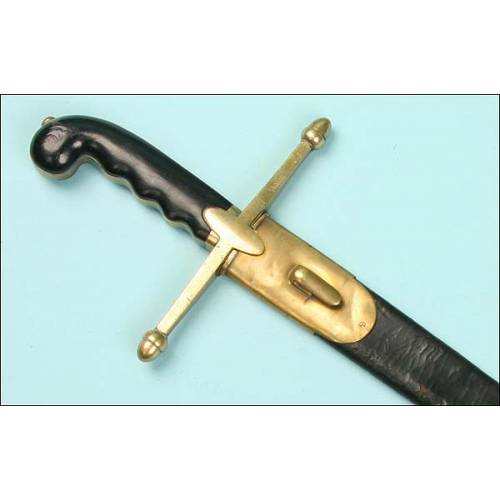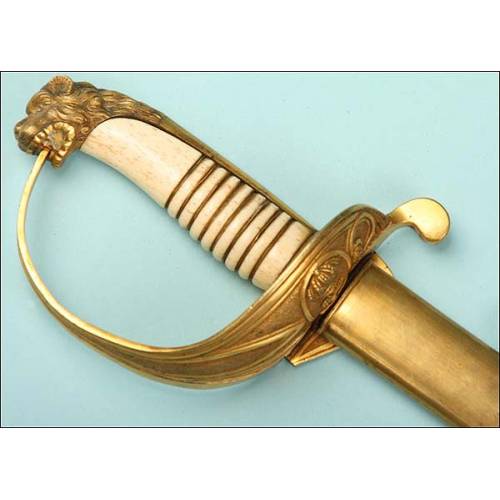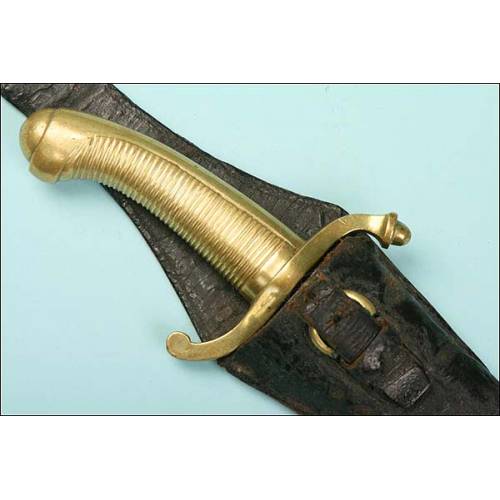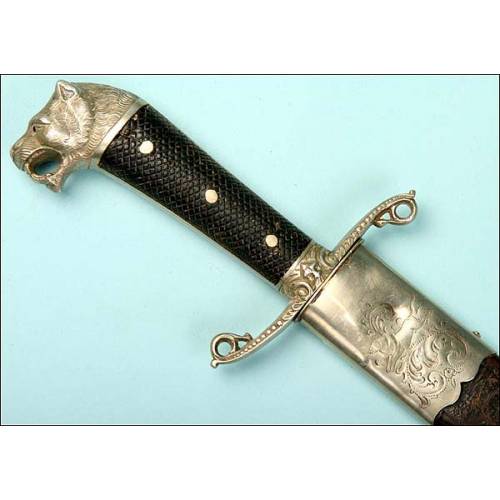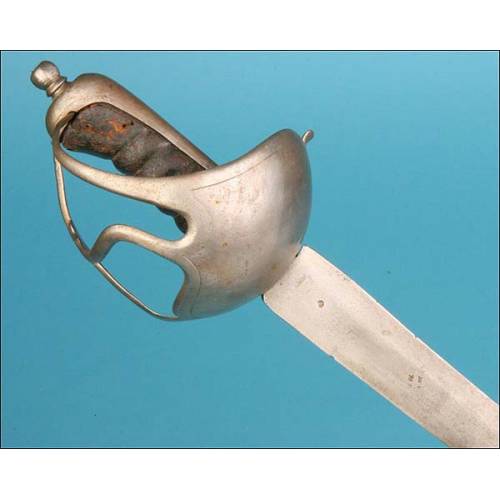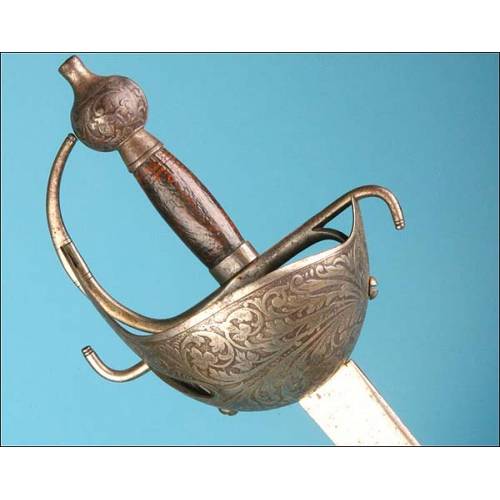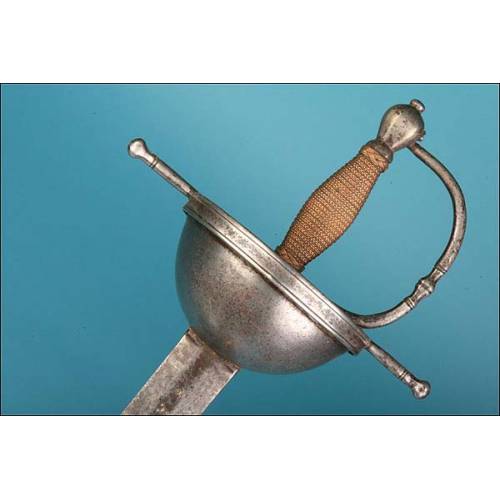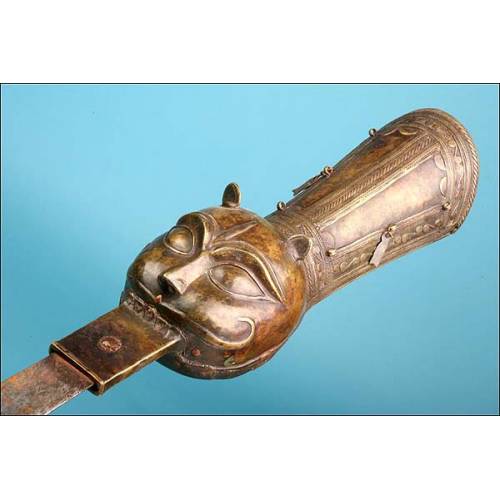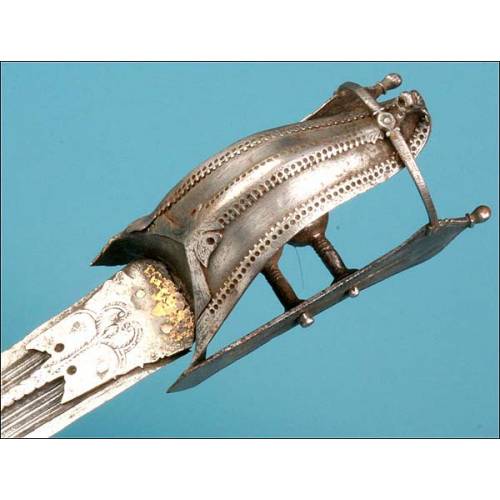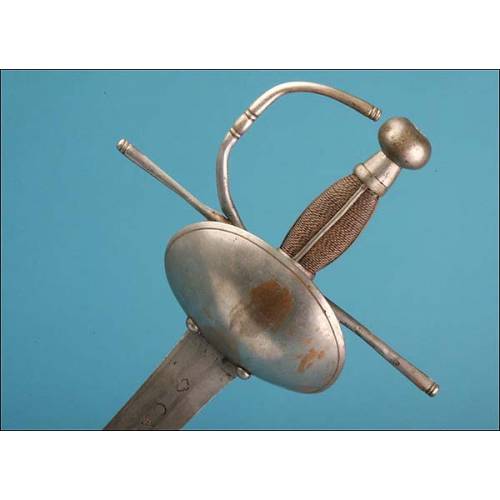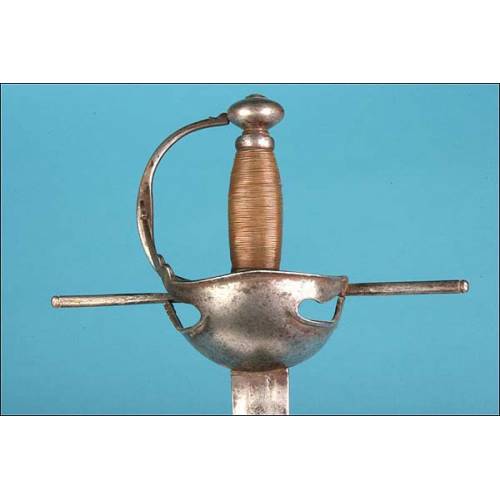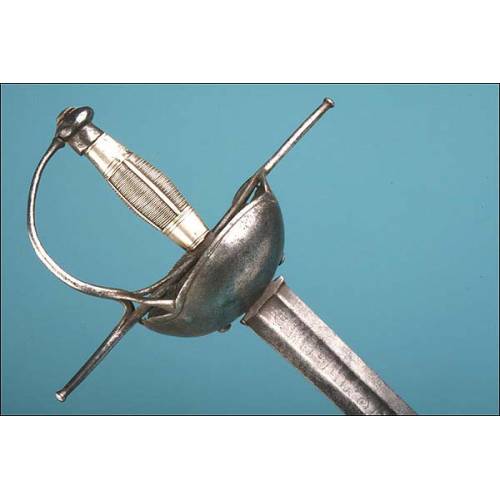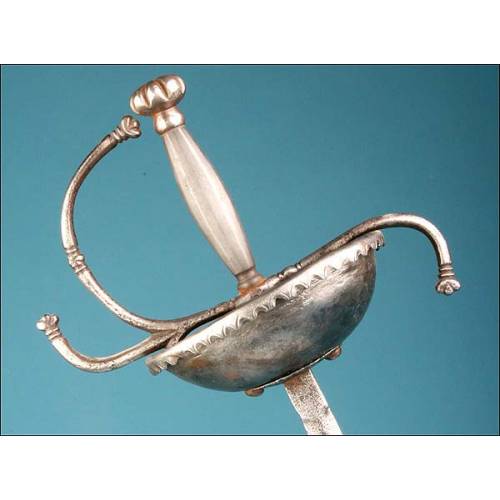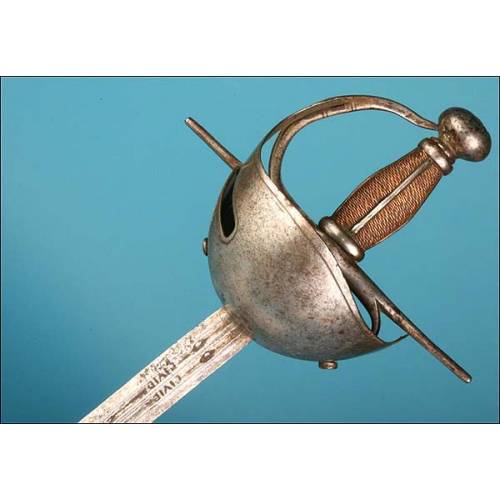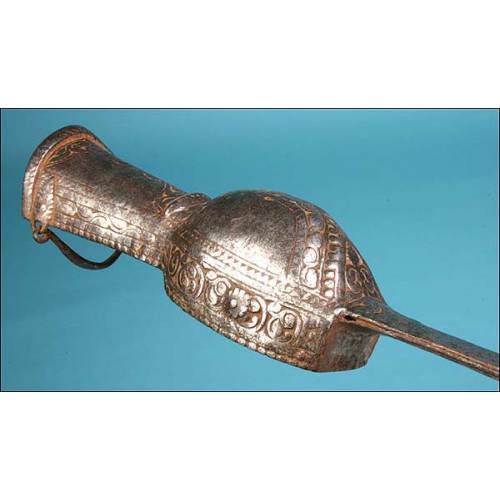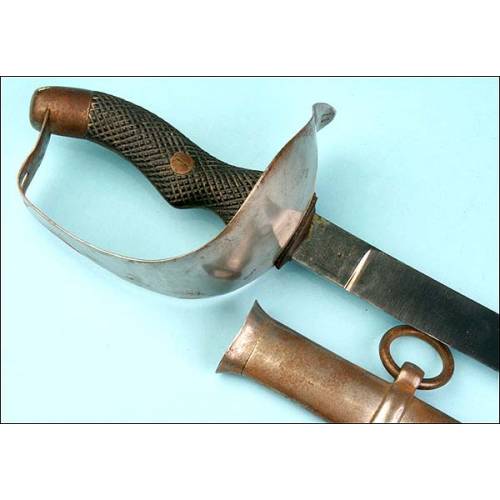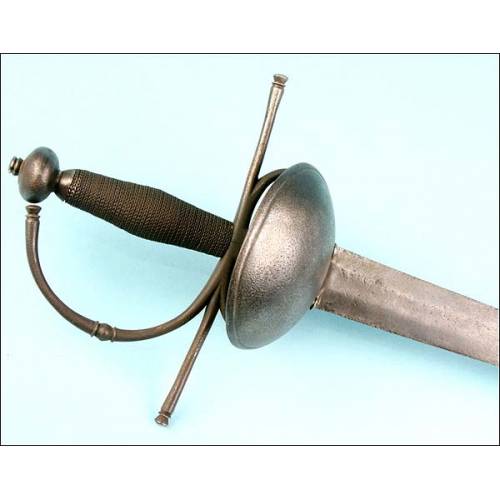J-068
Light cavalry officer's saber. National Guard. France. 1799-1804
Light cavalry officer's saber of the National Guard. France. Consulate period 1799-1804
Sold!
Light cavalry officer's saber of the National Guard. France. Consulate period 1799-1804. Blade engraved with the legend: Por la Patrie" on one side and on the other side "Garde National". Length of the sword with scabbard, 92 cms, without scabbard, 86 cms, and 73 cms only the blade. Germany. Executioner's sword. Made between 1710 and 1740 by the German swordsmith Wilhem Kirchoff. Very rare. This weapon was used to cut off people's heads and execute death sentences. They also cut off the hands of thieves, arms, etc. The owner of the sword was the local executioner. It was considered a vile, detestable weapon, unfit for a gentleman. That is why the tip is rounded. The executioner's swords are engraved with symbols of justice, in this case, it has on one side the gallows and on the other, the wheel of fortune. The weapon is 107 cm long, the blade is 5 cm wide and 85 cm long. The hawks are 20 cm wide and the hilt measures 21.5 cm. It is a weapon to be wielded with both hands. Central Asian sword, circa 1800. The blade is of exceptional thickness. The scabbard is made of wood covered with leather. The whole set is in a fantastic condition. The weapon measures 83 cms with the scabbard, 79 cms without scabbard and 66 cms only the blade. This is an 1870 model 1870 Spanish Army General officer's girding sword. It has a beautiful mercury gilded bronze hilt and a beautiful shiny blade skillfully decorated with floral ornaments and the coat of arms of Spain. As you can see it is in excellent condition and complete with its scabbard. The weapon measures 97 cms with the scabbard, 94 cms without scabbard and 80 cms just the blade. This is a German Nazi officer's sword during WW2. Of course it is totally original. The hilt is mercury gilded bronze and the pommel is a lion's head with the eyes formed by two rubies. It is in a magnificent state of preservation. The weapon measures 87 cms with the scabbard, 85,5 cms without scabbard and 72 cms only the blade. A beautiful 19th century Spanish knife made in Toledo according to the French Thiers model. The punch in which appears engraved its place of invoicing, TOLEDO. The handles are made of horn and brass, with geometrically arranged rivets. As a rarity, the blade is engraved with the legend Viva España, although quite attenuated by the passage of time. Beautiful and well preserved piece that closes perfectly. The spring has a fluid movement and the blade fits perfectly. The length of the weapon closed is 15 cms and open 27 cms. Prussian infantry machete, 1855 model. The pommel is topped by a small spherical shape. The blade is of the prestigious German manufacture P. D. L. (Peter D. Luneschloss), as attested by the engraving on the back of the moustache, and is in perfect condition. It remains in superb condition with magnificent luster throughout. The scabbard is brown leather, also in good condition. The overall condition of the gun is superb. The length of the weapon is 62 cms and the blade is 48 cms. Lebel Bayonet, France, Model 1886-91. In perfect state of preservation. The scabbard is made of iron and ends in a small ball. It is blued. The weapon is in very good condition. The length of the weapon is 63,50 cms and the length of the blade is 51,50 cms. Nazi saw for Engineer troops. Of German manufacture, made in 1941 by E. Winterhoff & Co. On its surface it exhibits engravings that identify the German manufacturer, its year of manufacture, 1941, reference number and a small eagle identifying the Nazi army. Both the blade and the teeth show a magnificent state of preservation. The scabbard is made of black dyed leather, with a black leather bolster and a metal ring clamp of the same material and with the same finish. It is in very good condition. The length of the weapon is 55 cms and the blade 42 cms. Swiss dagger-bayonet of the Waffenfabrik Neuhausen factory, model 1918. The steel of its blade shows a clean luster, and a magnificent condition of its running edge from the mustache to its tip. Accompanied by a nice original leather buckler in perfect condition. The length of the weapon is 43 cms and the blade is 30 cms. Short sword to be used as a regulation weapon by the police forces of Uruguay and Argentina. The blade itself came from the German factory in Solingen, while its hilt was made in South America and, sometimes, in Europe. The blade, on one side shows the identification of its German manufacturer and on the other side the effigy of a rooster, usual symbol in the swords of the police forces of both countries. It is in very good condition. The sword has a blade almost Prussian style but of reduced dimensions. The scabbard is the original leather one. The buckler has a nice loop instead of a button. Among the anecdotes of its use, it is worth mentioning that the use of the hard part of the blade, which lacks an edge, was encouraged to strike criminals. This is how the members of Butch Cassidy's gang related it, battered and from their cells, after being captured during the commission of their last robbery in Salto, Uruguay, in 1917. The length of the weapon is 76,50 cms and the blade 62,50 cms. Elegant British diplomat's rapier dating from the end of the 19th century that is offered even adorned with its original tassel. The handle is domed, with four carved edges. The shell that protects the cuff is also decorated. It is necessary to emphasize the great decorative profusion of the blade, with a great variety of vegetal elements and allegorical motifs to the British crown. In the upper zone it also mentions its manufacturer: Hill Brothers. Old Bond St. London. W.. The scabbard, in darkened leather, is reinforced with beautiful carved rim and ferrule. The length of the weapon is 94,50 cms and the blade 79,50 cms. Rare Spanish machete from the Elizabethan period. This is a rare piece, as there were one or two per regiment. In very good condition, it was manufactured in 1868, XIX century. It has a dark patent leather scabbard with vertical stripes, and gilded brass ferrule and ferrule. The length of the weapon is 76 cms and the blade 62 cms. As a curiosity, note that the Revolution of 1868, for obvious reasons, suppresses the monogram of Isabel II opting, in this case, for a little compromised rhombus, both in the obverse and in the reverse of the cross, and a small circle in the pommel. Possibly it was in use during the Regency of Serrano, the Reign of Amadeo I and even the First Republic. Curious machete in the style of the French artillery machete model 1771 in very good state of preservation. We believe it could be a good replica. Its hilt is all in brass. Its curious handle stands out, which is of a single piece and is formed by an eagle's head raised vertically and its stretched neck of feathers. The hawks are straight and finished in a circular finish and one of its sides is engraved with the numbering 1807 N. The blade is attached to the handle by three rivets and a crimp or wings of the blade visible on both sides of the handle, a special feature of the second manufacture of this model of machete. The pommel of the handle becomes the beak of the eagle and below it the contrast R can be seen. Another peculiar characteristic of this type of weapon is its blade, with edge on both sides and with three half-round vaceos: two parallel ones in the part closest to the handle and another one of greater length from where the previous ones end and up to the tip. The blade shows no trace of rust. The scabbard is made of dark brown leather, with brass reinforced mouthpiece and bolster. On it is engraved the inscription: Renault Jauchuey. 325. The length of the weapon is 62,50 cms and the blade 47,50 cms. Hunting sword or machete, from the end of the XVIII century, probably German or Dutch, in very good state of preservation. In one of its sides, the cross has an escutcheon in the center in the form of shell, typical of this type of white weapon of the end of the XVIII century. The handle is formed by two horn handles (probably deer) fastened with three riveted pins. The scabbard is made of undyed natural brown leather without metal reinforcements. The length of the weapon is 68,50 cms and the blade 55 cms. Excellent Spanish machete for artillerymen and engineers, model 1843. It stands out its magnificent state of preservation, keeping unalterable all the decorative work. The blade is wide, with the engraving Fca. de Toledo, 1876. It is in very good condition, with the angle of the tip tremendously sharp. The scabbard is the original leather scabbard, with a leather bolster. The butt is made of brass, topped by a small sphere. The length of the weapon is 56,50 cms and the blade is 41,50 cms. Nice infantry officer's sword from the time of the Austro-Hungarian Empire. Dated, therefore, in the 19th century. It has a brass hilt and a pommel with the head of a lion turned to the left and a very sinuous and decorated handguard ring, in the center of which stands out a vegetal ornamentation that forms interlacing. The handle is beautifully made of mother-of-pearl that allows precious iridescent reflections of light. One of the sides shows a minimal crack, not tarnishing its elegant presence. Its base is made of brass, where two inscriptions are carved: on the reverse viribus unitis, referring to the personal motto of Emperor Franz Joseph I (with union of forces); on the obverse FJ1, i.e. the initials of the emperor himself. It shows a cross of sparrowhawks with a gallinule, ferrule and frontal shell showing the imperial coat of arms. The blade is straight, with central channel and two cutting edges in good condition and without traces of oxidation. The length of the weapon is 94 cms and the blade 81 cms. Robust Spanish machete manufactured in 1890, according to a model regulated in 1881. The steel of the weapon presents a very good general state of conservation of the whole. On the blade are engraved the place and date of manufacture, Artillery Factory of Toledo, 1890. The leather scabbard is supple and in good condition. Declared regulation in 1881, its destination included artillery troops, engineers, sanitation, military administration, and even the musicians of the regimental bands and the infantry gastadors. The length of the weapon is 72.50 cms and the blade 59 cms. Spanish bayonet knife model 1941 whose blade is considered to be the second genuinely Hispanic design of direct descent from the falcata. At first, this knife-bayonet was designed for use in the old Mauseres models 1893 and 1916, used in all the Armed Forces, because of its dimensions it was adaptable. For its use in the 1943 model Mauser musket, where it was finally used, an additive had to be placed in the guide located under the barrel. The length of the weapon is 37.50 cms and that of the blade 25 cms. French grenadier saber, dated around 1770. It has a slightly curved blade, flat on the spines and a single edge. It presents a good general state of preservation. The hilt is made of brass. The pommel ends in a button, forming a curious symmetry, when sheathed, with the buttoned end of the scabbard. The scabbard is made of dark brown leather and has an oval button for the pommel. The length of the weapon is 73,50 cms and the length of the blade is 60 cms. British Yeomanry cavalry officer's saber, dated circa 1800, 19th century. The well-preserved, single-edged, sharply curved blade is made with a deep groove on each side of the spine. The tip of the blade is in excellent condition and the cutting edge is practically intact. On the blade there are some slight superficial marks due to old oxidation, which enhance its beauty and authenticity. In its harness it has a running bolster crowned with a lion's head pommel and a ferrule in which its tail enters, being made of iron with a gilded finish. The profusion of details in the definition of the long mane of the decorative lion is very remarkable. The handle is finished in ivory carved with tiny rhomboid geometries to facilitate its grip; given the delicacy of the material and the passage of time shows some cracks on both sides, although the overall condition is correct, not tarnishing the beauty of its contemplation. The handguard consists of a slightly decorated ring in its longitudinal ends that, starting from the pommel's mouth, ends with a sinuous form when it joins the cross; cross that in its other end exhibits a rounded sparrowhawk and turned towards the tip of the weapon. At its junction with the cross, the blade is protected by the latter with protrusions with the type of ornamentation mentioned for the rim. The scabbard, of black leather, is the original of the sword and fits like a glove; with two well-preserved bucklers although in the first of them a somewhat open edge can be observed; both are in burnished steel, like the bolster with a hinge, with its corresponding fastening ring and, the first one, exhibits an oval button for the baldric. The buckler and bolster are finished with decorative sinuous forms. The length of the weapon is 89 cms and that of the blade 76 cms. With a single-edged straight blade, with two wide grooves on each side along its entire length, this 1813 French cavalry XIII Curassier saber represents an exceptional case. Normally, the French navy tended not to mark their swords with contrasts of their regiments, although in rare cases, such as the one in question, this action did occur, as can be seen in the area of the blade closest to the hilt. Likewise, on the first longitudinal third of its blade, the engraving on the square spine to the interior stands out, as follows: M-fture Imp le de Klingenthal Octobre 1813. This clears up doubts about its place of manufacture in France and its dating. As for its historical background, it is believed that a significant number of them were captured by Prussian troops during the invasion of France in 1814, to be used by their cavalry regiments. In exceptional state of preservation, the weapon has a rust-free edge, enormous brilliance on the blade and an unaltered tip. The scabbard is made of steel, with a mouthpiece fastened with two screws, two clamps with their corresponding rings and a hinged tip. The hilt has a brass hilt, formed by a handguard and three branches attached to the guard, and the wooden handle lined with leather (either shark or ray) is wired with brass twine in the form of a double-wire braid, all in very good condition. The harness is marked with an obvious serial number. The length of the weapon is 113 cms and the blade 95,5 cms. Excellent Argentine artillery machete, model 1909, in very good condition. The blade is in impeccable state of preservation, magnificent brightness of the metal in all its extension, being straight, robust and of respectable length and width. It has a moustache engraved on one side with the inscription Argentine Model 1909 around the Argentine coat of arms; on the other side, the manufacturer's reference WEYERSBERG KIRSCHBAUM & CO. SOLINGEN. The scabbard is metallic. With its original leather buckle. The length of the weapon is 50,50 cms and the blade 37,5 cms. Argentinean machete of German manufacture, made in Solingen for the mauser rifle also made in Germany for the Argentinean army, and regulation of the same year 1891. The scabbard is metallic. The blade is shiny on all its surface. Most of the bayonets of this type came from a batch of 10,000 rifles acquired by the Spanish Government in November 1893 for use first in Melilla and then in the Cuban campaign. The length of the weapon is 52 cms and that of the blade 40 cms. Spanish saber for foot sergeants, according to the 1879 model. Brass harness cast in one piece. It comes from the 1818 model for infantry that, in turn, is a copy of the French model An 13 (1804), which came from the An 9 (1800) that, in turn, came from the models of the end of the XVIII century. Its blade is slightly curved and is shiny on its entire surface. The blade is engraved with the coat of arms of the Toledo Arms Factory. It is in very good condition. Finally, the leather scabbard is reinforced with a brass bolster and ferrule. The French soldiers, in its day, called it mockingly with the nickname of briquet (lighter) because of its small size. Its usefulness for the Spanish troops disappeared around 1841, remaining only in service as a badge for sergeants. It was manufactured in various blade sizes. The length of the weapon is 84 cms and the blade 70 cms. Its appearance and state of preservation are very good except for one of the cup rings that has a cut. The blade is a Puerto Seguro model, and is engraved TOLEDO. SPAIN. Both the latter and the surface of the blade in general are in excellent condition, showing a shiny appearance. The scabbard is also very well preserved. The length of the weapon is 90 cms and the blade 77 cms. American machete used in the Spanish-Cuban war during the late 19th century. The machete of the enemy, of the American troops. This model exhibits a reddish leather scabbard beautifully decorated with vegetal and geometric motifs. It is made of brass, and the constant width of the bolster, rounded at the end and reinforced, stands out. The pommel has the shape of an eagle's head of very beautiful workmanship. The blade is straight, angled at the end to end in a point that is still very sharp today; it has a square spine up to the middle and sharp edges on the rest. The length of the weapon is 81.50 cms and that of the blade 68 cms. Antique Spanish penknife signed by Valero Jun. Zaragoza, 19th century. Blade with hollowed out upper half and metal lining inside the handles. On the blade appears the signature of the maker: 'VALERO JUN ZARAGOZA'. This piece is undoubtedly notable for its beautiful irregular profile handles that alternate brass plates with rectangular horn plates, held in place with small circular nails and decorative flowers in the center. A beautiful, well-preserved piece that offers a perfect lock, with fluid movement of the spring and precise fit of the blade. Razors are a type of offensive weapon closely related to the history of Spain. The classic penknife appeared in Spain at the end of the 16th century, in such a generalized and practical way that it soon spread throughout our geography. It soon became a necessary weapon to guarantee security in the face of a possible unexpected attack, since the poverty of the time did not allow the establishment of rural police or public lighting to guarantee public safety. At that time, certain weapons, such as swords and sabers, were reserved for use by the noble class and the militia, while the ordinary citizen also needed to have an equally effective instrument, and that is when the penknife appeared. It was a weapon that, despite its smaller size, had the advantage of doubling in size when opened and also weighed less, which made it easier to carry and conceal. This, coupled with a sharp blade with a sharp point, ensured its effectiveness. Beautiful original collector's item in very good condition, which tells the story of a past where citizen security was very different. The length of the blade is 18,5 cms and open 41 cms. Elegant Spanish Army Infantry Officer's Machete in Cuba, ca. 1891. It has a decorative and well defined hilt with an ivory bone handle and pommel in the shape of a perfectly detailed horse's head. All the details of the animal can be seen, such as the bridles, teeth, eyes and hair, which undoubtedly show the mastery of the design. On the lower part of the pommel there are two lion heads in a cross and center with beautiful vegetal decoration with two crossed swords. It is in perfect condition, with its original leather scabbard with brass reinforcements very well maintained and with all its flexibility. The blade in steel with inscription and numbered: nº 902, is in very good condition. The blade is straight and flat, without mustache, channels or vaceos, being its flat back. It ends abruptly diagonally forming the tip. It presents some slight pitting or age spot without importance, which is perfectly reflected in the photographs. The tip is perfectly defined, and has never been trimmed. A person knowledgeable in the matter will know how complicated it is to find a machete of these characteristics with a well defined tip, since almost all of them have a more or less rounded or worn tip. In this piece the tip appears in perfect condition, but it is its original tip, a piece that can not be missed! Spectacular Ottoman Kilij in Solid Silver with Gold Inlay, XIX Century. Beautiful handle with an original knob carved in the shape of a conch shell with a delicate silver flower in the center. It is decorated on the sides by a vertical silver line with interlaced vegetal forms. The cross-shaped garnish with two of its longer sides, the hawk, is also silver and continues the engraved vegetal decoration, highlighting in the center a simple six-petal flower. Curved steel blade with precious gold inlaid Arabic calligraphy with verses from the Koran on both sides. In excellent state of preservation. The saber is a type of white weapon similar to the sword, but generally of curved blade and of a single edge like this example. Its origin is usually attributed to the oriental peoples, more specifically to the Turks and Persians. These types of weapons also follow the fashions of the time, and adopt very different shapes and styles. In the East, the saber had a great acceptance as a defensive weapon and was used assiduously, hence the variety of models that we can find. Europe, more in favor of the sword, this weapon did not appear until well into the 18th century. The origin of this type of weapon can be found in Persia, although it was also used in India during the 13th and 14th centuries. Its long, curved blade was designed to sweep enemies with thrusts, as well as to stab deeply. The particularity that the blade is curved serves so that when attacking on horseback the blade does not become embedded in the opponent, in addition to the fact that the blade cuts but also follows its trajectory. The Ottoman Kilij are similar to what we can call saber or scimitar with the particularity that it has a pronounced counter-blade at the tip known as Yelman. An interesting anecdote is that this type of sword forms the basis for the Mameluke sword of the United States Marine Corps. During the Napoleonic Wars, in the French conquest of Egypt in 1831, these beautiful and functional weapons were discovered, and have since been used as a model for Marine Corps equipment. A spectacular piece for very special collectors who appreciate its value. Measurements: 99 cm (length). Magnificent 19th century Officer's Saber. This is an ultra rare and uncatalogued piece. It has the same hilt as the infantryman's machete (soldier that was applied to the work of opening trenches and other similar, or to clear the way in the marches, for which they carry shovels, axes and picks) so the present piece could be a rare infantry officer's saber. It has a beautiful hilt with an original chiseled pommel in the shape of a lion's head with a long neck. It is an open mawed beast made with great detail, as we can perfectly appreciate the teeth and hair, as well as a kind of plumage that covers the neck area. The cross-shaped harness is very simple and only appears decorated with two small balls at the ends. The curved steel blade is in perfect condition. This fantastic piece also comes with its original scabbard, made of leather with golden metal reinforcements, two of which include washers to attach the sword and facilitate its transport.

